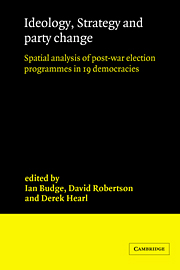 Ideology, Strategy and Party Change
Ideology, Strategy and Party Change Published online by Cambridge University Press: 27 October 2009
INTRODUCTION
Sri Lanka is an island nation lying twenty-five miles off the southern tip of India. It is densely populated, with about fifteen million people residing within its 25,332 square miles. The population consists of roughly 71 percent Sinhalese (largely Buddhist), 21.6 per cent Tamil (largely Hindu), and smaller racial groups. Each is a self-conscious and well-defined community. Much of the island was dominated from the late sixteenth century by European powers – first the Portuguese, then the Dutch and finally the British who displaced the Dutch in the 1790s. In February, 1948, Ceylon became a self-governing state within the Commonwealth, and in 1972, a republic retaining Commonwealth membership, under the name of Sri Lanka.
The British shared power more generously with the Ceylonese than with other non-Western peoples. As a result, the island has had a longer experience of elections on the basis of universal suffrage than any country in Afro-Asia with the exception of Japan and the Philippines. Nonetheless, the first two Ceylonese elections under universal suffrage in 1931 and 1936 are omitted from this discussion because the Donoughmore Constitution, under which they were conducted, intentionally prevented the formation of political parties by fragmenting power among seven discrete committees in the State Council (the island's legislature) and among the Ministers which each committee elected.
Our study begins with the general election of 1947 which was held under a new constitutional structure based on the Westminster model which continued in use until 1972.
To save this book to your Kindle, first ensure no-reply@cambridge.org is added to your Approved Personal Document E-mail List under your Personal Document Settings on the Manage Your Content and Devices page of your Amazon account. Then enter the ‘name’ part of your Kindle email address below. Find out more about saving to your Kindle.
Note you can select to save to either the @free.kindle.com or @kindle.com variations. ‘@free.kindle.com’ emails are free but can only be saved to your device when it is connected to wi-fi. ‘@kindle.com’ emails can be delivered even when you are not connected to wi-fi, but note that service fees apply.
Find out more about the Kindle Personal Document Service.
To save content items to your account, please confirm that you agree to abide by our usage policies. If this is the first time you use this feature, you will be asked to authorise Cambridge Core to connect with your account. Find out more about saving content to Dropbox.
To save content items to your account, please confirm that you agree to abide by our usage policies. If this is the first time you use this feature, you will be asked to authorise Cambridge Core to connect with your account. Find out more about saving content to Google Drive.